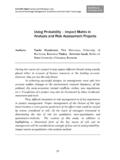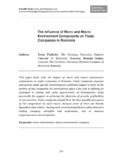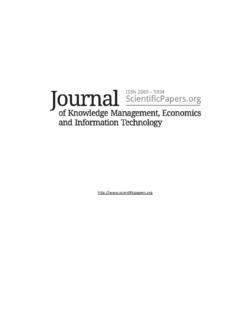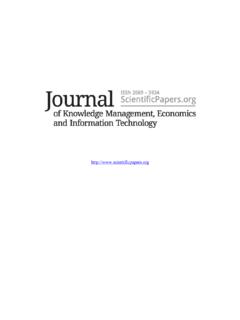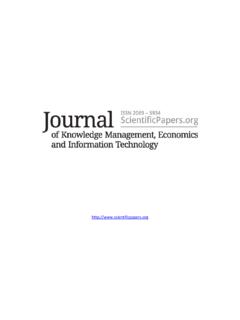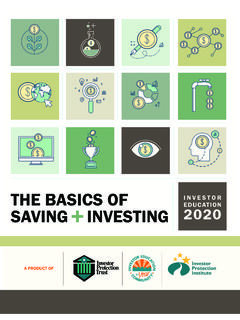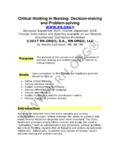Transcription of The Investments in Education and Quality of Life
1 Scientific Papers ( ) Journal of Knowledge Management, Economics and Information Technology 141 Special Issue December 2013 The Investments in Education and Quality of Life Authors: Dan Dumitru Ionescu, Alexandru Ioan Cuza University of Iasi; Alina M riuca Ionescu, Alexandru Ioan Cuza University of Iasi; Elisabeta Jaba, Alexandru Ioan Cuza University of Iasi A considerable amount of literature has investigated positive economic and social outcomes that learning may have both for individuals and for societies. Better-educated people typically have better health status, lower unemployment, more social connections, and greater engagement in civic and political life. This paper aims to explore the relationship between Investments in Education and research and the level of Quality of life in a country. The Investments in Education and research are expressed in terms of expenditure on Education and research, financial aid to pupils and students and public subsidies to private sector.
2 For the assessment of Quality of life there were considered three well-known composite indicators: Human Development Index, Economist Intelligence Unit Quality of Life Index, and Satisfaction with Life Scale. The analysis is done using data on European Union 27 member states, which come from Eurostat database and from specialized institutions sites. The study shows a positive relation between Investments in Education and Quality of life. It identifies the annual expenditure on public and private educational institutions per pupil/student and the gross domestic expenditure on research and development as being the indicators of Investments in Education that best predict the level of Quality of life in a country. The Investments in Education and Quality of Life 142 Special Issue December 2013 Keywords: Education ; Quality of life; investment in Education Introduction Education is a key issue in the research studies and in public debates on Quality of life (QOL).
3 In the beginning of 2000s, Education has been on the list of priorities of the Lisbon strategy in order to sustain the efforts to improve the economic competitiveness and increase the quantity and Quality of jobs (Ashiagbor, 2005; Vesan and Bizzotto, 2011, p. 2). More recently, within the Report by the Commission on the Measurement of Economic Performance and Social Progress, Education was again among the focused eight key domains when defining well-being (Stiglitz et al., 2009, pp. 14-15). Education or aspects of Education such as literacy, knowledge, and mental development are among the domains of human life considered in the construction of most of the international indexes of development and QOL (Hagerthy et al., 2001) and in most of the governmental social monitoring frameworks (Vesan and Bizzotto, 2011, p. 8). Education is also among the categories considered in most of the multidimensional approaches to human well-being and progress proposed by different authors (Alkire, 2010).
4 Following the broad interest manifested both in the research literature and among policy-makers for the study of positive effects of Education on QOL, the present paper aims to identify and characterize certain relationships that might appear between Investments in Education and QOL. The analysis is focused on 27 European countries. The research has been organized as follows: it first presents a short literature review about the positive effects of Education on QOL and about the relationship between Investments in Education and QOL; the next section describes the methodological issues (sample, indicators, method); the paper continues with the presentation of the main results The Investments in Education and Quality of Life 143 Special Issue December 2013 concerning the way Investments in Education may predict QOL and ends with concluding remarks. Literature review Positive effects of Education on Quality of life There is a consensus that Education brings a range of returns (monetary and non-monetary) that benefit both the person investing in the Education and the community in which they live (Stiglitz et al.)
5 , 2009, p. 46). Schuller (2007, p. 8) identifies earnings, income, wealth and productivity as possible monetary outcomes of learning for individuals, while monetary outcomes of learning at public level refer to tax revenues, social transfer costs, and health care costs. Schuller (2007, ) also suggests positive non-monetary outcomes of learning on individuals in the form of improved health status and life satisfaction. At community and society level, non-monetary outcomes of learning refer to social cohesion, trust, well-functioning democracy, and political stability. Among the social outcomes of learning Pfeifer (2007) mentions the following: a well-educated person can achieve social and economic progress by herself; wealthier people and higher standards of life are positively correlated with more and better Education ; poor kids in good schools do better in life. Education empowers a person and it helps people to become more proactive, gain control over their lives, and to broaden the range of available options (UNESCO, 1997, in Khan and Williams, 2006, p.
6 2). Beyond its effects on people s earnings and productivity, Education helps them in achieving a variety of outcomes that matter for QOL. Evidence indicates that individuals who attended school for longer, or who achieved higher educational qualifications, are more likely to report greater subjective well-being (Oreopoulos, 2007; Helliwell, 2008, cited in Stiglitz et al., 2009, p. 166), to enjoy better health and to participate more actively in society. Education may enable people to live The Investments in Education and Quality of Life 144 Special Issue December 2013 more positively healthy lives (Schuller, 2007, p. 5; Goldberg, J. and Smith, J., 2007, p. 14; Stiglitz et al., 2009, p. 166). Better educated people record lower mortality rates (Mackenbach, 2006), less serious health problems (such as diabetes and high blood pressure) and less common illnesses (such as colds, headaches and aches) (Stone et al., 2008), and increased access to health care (van Doorslaer et al.
7 , 2004). Education can foster civic and social engagement (CSE) by shaping what people know; by developing competencies that help people apply, contribute and develop their knowledge in CSE; by cultivating values, attitudes, beliefs and motivations that encourage CSE; by increasing social status (Schuller, 2007, p. 5). Education is also a key to social inclusion as it enables citizens to make use of existing possibilities for full engagement in social and political life as active citizens (Souto Otero and McCoshan, 2005, p. 13). Investments in Education and Quality of life Vast research literature provides evidence of the value of investing in Education to develop human capital and of its contribution to economic development and growth (Fasih, 2008, pp. 8-9). In their Final Report for the European Comission entitled Study on Access to Education and Training Tender No EAC/38/04, Lot 1, Manuel Souto Otero and Andrew McCoshan (2005, p.
8 8), discussing about the importance of Education in the context of Lisabon strategy Europe 2010, underline the crucial role of Education and training in achieving economic progress and social inclusion: Investing in people and developing an active and dynamic welfare state will be crucial both to Europe s place in the knowledge economy and for ensuring that the emergence of this new economy does not compound the existing social problems of unemployment, social exclusion and poverty (Council of the European Union, 2000, in Souto Otero and McCoshan, 2005, p. 11). Since Investments in Education as other kinds of investment are evaluated in terms of their rates of return, studying them can highlight The Investments in Education and Quality of Life 145 Special Issue December 2013 public and private investment priorities in resources allocation, with regard to level of study, curriculum type, sector and gender. Social returns could indicate to governments which are priority investment areas among alternative schooling levels and programs (Tansel, 2004, p.
9 39). One direct consequence of Investments in Education is a broadened access to Education , either by allowing a greater number of people to receive Education or by facilitating access to more competencies, or by both ways. Aggarwal et al. (2010, p. 14) notices that an increase in spending on Education leads to an increase in the propensity for young people to undertake Education . Later in the life cycle, the human capital that they have acquired equips these young people to undertake jobs that are qualitatively different from those in which they would otherwise have become employed. That means that more people get better jobs. Inspired by Mincer earnings model, which derives directly from the assumption that individuals are paid based on their marginal productivity, Kuepie et al. (2006) suggests that Investments in Education are an explanatory factor in the distribution of earnings.
10 Under this assumption, a strong implication in terms of economic policy is that if inequalities in income distribution are to be reduced in a given country, the starting point is to reduce inequalities in access to schooling, given that income inequality seems to be higher when Education is less equally distributed (Kuepie et al., 2006). The human capital theory, an economic rationalist approach, focuses on returns to investment in Education : Education and training (human capital) increase worker productivity and hence the value of educated workers. Thus, individuals who invest time, energy, and money into Education do so with the expectation of securing a better job and enhanced lifetime earnings. At the individual level, increasing Education (human capital) increases worker productivity and thus garners better employment and income for the individual. At the social or aggregate level, general increments in the stock of human capital are supposed to The Investments in Education and Quality of Life 146 Special Issue December 2013 increase overall productivity, prosperity, and social cohesion (OECD, 1998, 2001 cited in Edgerton et al.)
